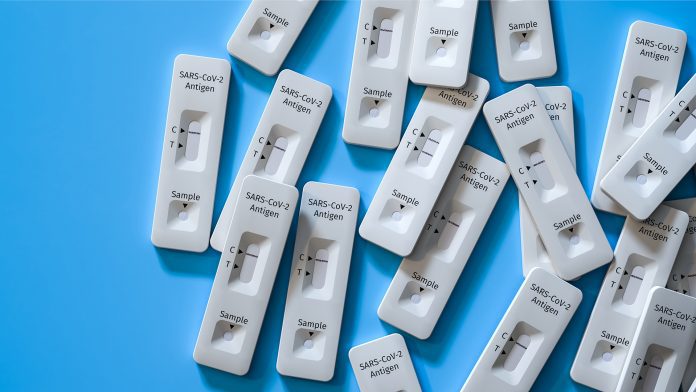
Researchers at the Paul Scherrer Institute (PSI) and the University of Basel have developed a new rapid Covid test. Its novel functional principle promises reliable and quantifiable results concerning a patient’s COVID-19 disease.
The challenge with the rapid Covid test – as demonstrated by a recent study by a research group led by Heinrich Scheiblauer of the German Paul Ehrlich Institute – is their lack of reliability. Furthermore, out of 122 rapid Covid test kits from different manufacturers that were tested for the study purposes, one-fifth failed and did not meet the minimum requirement of identifying 75% of the test subjects carrying a high viral load as COVID-19 positive. Additionally, insight is limited into the course of the infection or immune reaction of the test subjects.
The researchers reported on their rapid Covid test development in the Journal ACS Applied Nanomaterials; however, the device must undergo further testing and optimisation before widespread use.
A new rapid covid test
PSI has now developed a new rapid Covid test which, unlike antigen tests, does not directly detect components of the virus but focuses on the antibodies the immune system produces in response to the infection. It promises to bring substantially more predictive power to rapid Covid testing.
It is comparable to the current tests on the market as this new rapid Covid test is inexpensive, quick, and easy to use, and can also be used to simultaneously identify a variety of pathogens, such as those responsible for the flu.
“Thus, it also provides more data than previous rapid antibody tests that are used to determine whether someone has already had a coronavirus infection,” commented Yasin Ekinci, head of the Laboratory for X-ray Nanoscience and Technologies at PSI, who was responsible for the project to develop the new rapid Covid test.
The central building block of the rapid Covid test is a small rectangular plate of ordinary Plexiglas, similar to a microscope slide. It consists of a lower layer which is one millimetre thick, and an upper layer, with a thickness of 0.2 millimetres. The researchers patterned a relief in the lower part using electron beam lithography – an extremely precise process for milling solid materials used, for example, in the manufacturing of computer chips. Once the master template was produced in this way, the researchers combined this with so-called nanoimprint lithography, which significantly speeds up the fabrication process and reduces its cost.
Plexiglas plate has three parallel channels by which a fluid can flow from one end to the other. It is crucial for the passage known as the capture region that the height of the channel drops from 3.4 micrometres to 0.8. For the test, a subject would go to a doctor or a test centre. A drop of blood is taken with a prick of the finger, similar to a blood sugar test. A liquid in which special artificial nanoparticles are suspended is mixed into the blood. Their surface has the same structure as the notorious spike proteins of the Sars-CoV-2 virus, which human antibodies dock to when fighting the disease. In addition, small fluorescent particles are added that attach themselves to Sars-CoV-2 antibodies in humans.
This means that if there are antibodies against SarsCoV-2 in the blood being tested, the fluorescent particles first attach themselves to them; together, they then bind to the virus-like structures of the significantly larger nanoparticles and get stuck, along with them, in the predefined places corresponding to the diameter of the nanoparticles. Here the nanoparticles accumulate, with the human antibodies and their glowing appendages docked to them. If the plate is placed under a fluorescence microscope, the light signal is visible. The more antibodies the patient has formed, the brighter it is, the clearer the signal, the stronger the immune reaction. This is how COVID-19 can be clearly diagnosed.
Testing the new diagnostics
For the study, the rapid Covid test was tested with 29 blood samples – 19 of which came from infected people and ten from non-infected people. With the exception of one false-negative case, the test was always correct. This was identified during the follow-up test.
“Of course, we need to do a lot more testing to make a solid statement about reliability, and there’s still a lot of room for improvement. But it is very promising,” said Ekinci.
The rapid Covid test should become easier to carry out. The researchers have noted that they are working on making the test just as easy to do with saliva instead of blood. Furthermore, the researchers want to use a mobile phone camera instead of a microscope to read the signals.
“Our vision is a technology,” said Ekinci, “with which we can simultaneously diagnose several diseases and variants of Covid and flu reliably, quickly, and inexpensively via mobile phone. Our novel concept is capable of making this a reality.”
























